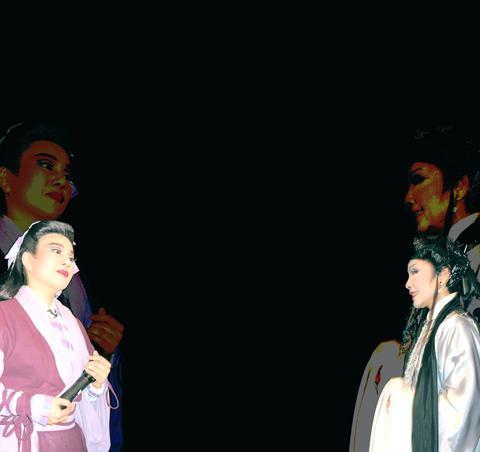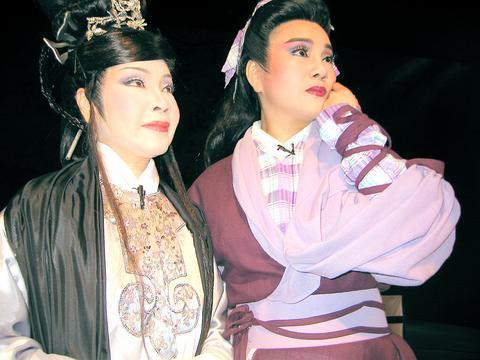Perched on a bench in a hallway outside a rehearsal room in the bowels of the National Concert Hall, Tang Mei-yun (唐美雲), in her track pants and T-shirt, is "the girl next door."
You certainly wouldn't think she was one of the best-known names in Taiwanese ke-tsai opera. She is no traditionalist, she admits as much herself, in a breathy staccato that suggests a backlog of words rushing to get out. She has been criticized for disregarding convention in the only operatic form that Taiwan can call its own, but her response is a feisty: "At least I'm keeping it alive."

PHOTO: IAN BARTHOLOMEW, TAIPEI TIMES
Five years ago Tang established the Tang Mei Yun Taiwanese Opera Company (唐美雲歌仔戲團), which has managed to release a new, original work each year, breathing new life into a form that has long been floundering under the assault of more sophisticated and venerable operatic styles now regularly being imported from China, as well as electronic media, which have affected the theater as a whole.

Tonight, Tang will be premiering The Immortal Lover (無情遊), her latest work, which, for the benefit of Western audiences, can be said to be loosely based on the Clint Eastwood film Bridges of Madison County (1995).
Very simply, The Immortal Lover tells the story of a young woman who is forced to marry a rich man rather than the man she loves. For her child's sake, she remains true to her husband despite the appeals of her lover. Her child discovers this story and after the initial shock, eventually comes to terms with his mother's spiritual infidelity.
"I liked the story," Tang said simply. "And it was a challenge to bring more modern romantic themes into the opera." To add to the challenge, Tang brought in one of the great names of traditional ke-tsai opera, Liao Chiong-chi (廖瓊枝), who is especially known for her presentation of suffering women.
At a dress rehearsal yesterday, Liao, 70, said the whole experience of playing in an "internal way" was very new and exciting.
"In traditional ke-tsai opera, when you cry, you cry all out, and when you laugh, you put everything into it. We didn't swallow our emotions. In playing this role, this was the most difficult thing for me to get used to," said Liao, who plays the Meryl Streep character in middle age.
"I kept on telling her to hold off on the weeping until the very end," Tang added.
The Immortal Lover was written around Liao, who, veteran though she is, found herself on unfamiliar ground in Tang's new work, where the conventions of emotional expression, which in Chinese opera are usually used to reinforce the social order, are gently subverted to allow the heroine into more tangled, less morally clear-cut territory.
"There is no rule saying that the ancients could not find love outside marriage," Tang said.
"It's just that people used to think that theater should be morally improving. ? We are more inclined to use a modern perspective to interpret the emotions of the ancients."
As for the music, for those used to the clanging tinny sounds of temple fair operas, the rich symphonic music that emerges from the orchestra pit will come as a surprise.
Presentation too is on a different scale, with simple, modernistic sets, multiple backdrops to create depth and a rotating stage. The whole thing is more theatrical than operatic, and is a million miles away from the rustic ke-tsai opera that was often little more than a number of arias loosely strung together, presented without the benefit of formalized gestures or dramatic structure.
The relatively parochial nature of ke-tsai opera gives Tang a great deal of the freedom that she relishes, allowing her to make bold experiments, as she has done with The Immortal Lover.
Her attitude is that if ke-tsai opera, with its relatively short and eclectic history, cannot incorporate new ideas and methods, then Chinese opera as a whole is doomed. "Even forms like nan-kuan, with its 1,000-plus-year history, is making changes," she said. "There is nothing stopping us."
Tang speaks with the authority of experience, for she comes from an operatic family, her father having performed during the hey-day of ke-tsai opera from the 1920s and early 1930s. It was a time when the simple local opera found itself transferred to big indoor stages, performing to packed houses, its stars on a par with major Hollywood figures today.
Its popularity has since fallen, but Tang believes some sort of revival is possible. To some extent this is related to the resurgence of Taiwanese consciousness, for ke-tsai is the only form of opera indigenous to Taiwan.
"It's a great way for kids to get in touch with the language," Tang said.
All of this has brought its share of criticism from traditionalists. "I can deal with it," said Tang confidently. "I make them tell me why they think something isn't right. I can take this criticism. But no one doubts that what Tang Mei-yun performs is ke-tsai opera. There is no question on that issue. I don't feel I have betrayed the art form in any way."

May 26 to June 1 When the Qing Dynasty first took control over many parts of Taiwan in 1684, it roughly continued the Kingdom of Tungning’s administrative borders (see below), setting up one prefecture and three counties. The actual area of control covered today’s Chiayi, Tainan and Kaohsiung. The administrative center was in Taiwan Prefecture, in today’s Tainan. But as Han settlement expanded and due to rebellions and other international incidents, the administrative units became more complex. By the time Taiwan became a province of the Qing in 1887, there were three prefectures, eleven counties, three subprefectures and one directly-administered prefecture, with

It’s an enormous dome of colorful glass, something between the Sistine Chapel and a Marc Chagall fresco. And yet, it’s just a subway station. Formosa Boulevard is the heart of Kaohsiung’s mass transit system. In metro terms, it’s modest: the only transfer station in a network with just two lines. But it’s a landmark nonetheless: a civic space that serves as much more than a point of transit. On a hot Sunday, the corridors and vast halls are filled with a market selling everything from second-hand clothes to toys and house decorations. It’s just one of the many events the station hosts,

Two moves show Taichung Mayor Lu Shiow-yen (盧秀燕) is gunning for Chinese Nationalist Party (KMT) party chair and the 2028 presidential election. Technically, these are not yet “officially” official, but by the rules of Taiwan politics, she is now on the dance floor. Earlier this month Lu confirmed in an interview in Japan’s Nikkei that she was considering running for KMT chair. This is not new news, but according to reports from her camp she previously was still considering the case for and against running. By choosing a respected, international news outlet, she declared it to the world. While the outside world

Through art and storytelling, La Benida Hui empowers children to become environmental heroes, using everything from SpongeBob to microorganisms to reimagine their relationship with nature. “I tell the students that they have superpowers. It needs to be emphasized that their choices can make a difference,” says Hui, an environmental artist and education specialist. For her second year as Badou Elementary’s artist in residence, Hui leads creative lessons on environmental protection, where students reflect on their relationship with nature and transform beach waste into artworks. Standing in lush green hills overlooking the ocean with land extending into the intertidal zone, the school in Keelung